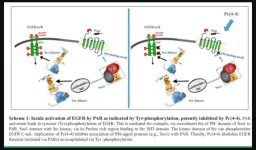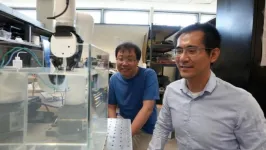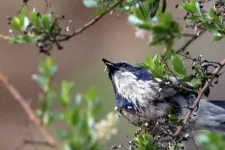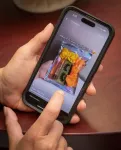(Press-News.org) ORLANDO, May 24, 2024 – For the first time, carbon dioxide and carbon monoxide ices have been observed in the far reaches of our solar system on trans-Neptunian objects (TNOs).
A research team, led by planetary scientists Mário Nascimento De Prá and Noemí Pinilla-Alonso from the University of Central Florida’s Florida Space Institute (FSI), made the findings by using the infrared spectral capabilities of the James Webb Space Telescope (JWST) to analyze the chemical composition of 59 trans-Neptunian objects and Centaurs.
The pioneering study, published this week in Nature Astronomy, suggests that carbon dioxide ice was abundant in the cold outer regions of the protoplanetary disk, the vast rotating disk of gas and dust from which the solar system formed. Further investigation is needed to understand the carbon monoxide ice’s origins, as it also prevalent on the TNOs in the study.
The researchers reported the detection of carbon dioxide in 56 TNOs and carbon monoxide in 28 (plus six with dubious or marginal detections), out of a sample of 59 objects observed with the JWST. Carbon dioxide was widespread on the surfaces of the trans-Neptunian population, independent of the dynamical class and body size while carbon monoxide was detected only in objects with a high carbon dioxide abundance, according to the study.
The work is part of the UCF-led Discovering the Surface Compositions of Trans-Neptunian Objects program (DiSCo-TNOs), one of the JWST programs focused on analyzing our solar system.
“It is the first time we observed this region of the spectrum for a large collection of TNOs, so in a sense, everything we saw was exciting and unique,” says de Prá, who co-authored the study. “We did not expect to find that carbon dioxide was so ubiquitous in the TNO region, and even less that carbon monoxide was present in so many TNOs.”
The discovery of the ices can further help us understand the formation of our solar system and how celestial objects may have migrated, he says.
“Trans-Neptunian Objects are relics from the process of planetary formation,” de Prá says. “These findings can impose important constraints about where these objects were formed, how they reached the region they inhabit nowadays, and how their surfaces evolved since their formation. Because they formed at greater distances to the Sun and are smaller than the planets, they contain the pristine information about the original composition of the protoplanetary disk.”
Chronicling Ancient Ice
Carbon monoxide ice was observed on Pluto by the New Horizons probe, but not until JWST was there an observatory powerful enough to pinpoint and detect traces of carbon monoxide ice or carbon dioxide ice on the largest population of TNOs.
Carbon dioxide is commonly found in many objects in our solar system. So, the DiSCo team was curious to see if it existed in greater quantities beyond the reaches of Neptune.
Possible reasons for the lack of previous detections of carbon dioxide ice on TNOs include a lower abundance, non-volatile carbon dioxide becoming buried under layers of other less volatile ices and refractory material over time, conversion into other molecules through irradiation, and simple observational limitations, according to the study.
The discovery of carbon dioxide and carbon monoxide on the TNOs provides some context while also raising many questions, de Prá says.
“While the carbon dioxide was probably accreted from the protoplanetary disk, the origin of the carbon monoxide is more uncertain,” he says. “The latter is a volatile ice even in the cold surfaces of the TNOs. We can’t rule out the carbon monoxide was primordially accreted and somehow was retained until present date. However, the data suggests that it could be produced by the irradiation from carbon-bearing ices.”
An Avalanche of Answers
Confirming the presence of carbon dioxide and carbon monoxide on TNOs opens many opportunities to further study and quantify how or why it is present, says Pinilla-Alonso, who also co-authored the study and leads the DiSCo-TNOs program.
“The discovery of carbon dioxide on trans-Neptunian objects was thrilling, but even more fascinating were its characteristics,” she says. “The spectral imprint of carbon dioxide revealed two distinct surface compositions within our sample. In some TNOs, carbon dioxide is mixed with other materials like methanol, water ice, and silicates. However, in another group — where carbon dioxide and carbon monoxide are major surface components — the spectral signature was strikingly unique. This stark carbon dioxide imprint is unlike anything observed on other solar system bodies or even replicated in laboratory settings.”
It now seems clear that when carbon dioxide is abundant, it appears isolated from other materials, but this alone doesn't explain the band shape, Pinilla-Alonso says. Understanding these carbon dioxide bands is another mystery, likely tied to their unique optical properties and how they reflect or absorb specific colors of light, she says.
It was commonly theorized that perhaps carbon dioxide may be present in TNOs as carbon dioxide exists in a gaseous state in comets, which are comparable in composition, Pinilla-Alonso says.
“In comets, we observe carbon dioxide as a gas, released from the sublimation of ices on or just below the surface,” she says. “However, since carbon dioxide had never been observed on the surface of TNOs, the common belief was that it was trapped beneath the surface. Our latest findings upend this notion. We now know that carbon dioxide is not only present on the surface of TNOs but is also more common than water ice, which we previously thought was the most abundant surface material. This revelation dramatically changes our understanding of the composition of TNOs and suggests that the processes affecting their surfaces are more complex than we realized.”
Thawing the Data
Study co-authors Elsa Hénault, a doctoral student at the Université Paris-Saclay’s Institut d'Astrophysique Spatiale, and French National Center of Scientific Research, and Rosario Brunetto, Hénault’s supervisor, brought a laboratory and chemical perspective into the interpretation of JWST observations.
Hénault analyzed and compared the absorption bands of carbon dioxide and carbon monoxide across all objects. While there was ample evidence of the ice, there was a great diversity in abundance and distribution, Hénault says.
“While we found CO2 to be ubiquitous across TNOs, it is definitely not uniformly distributed,” she says. “Some objects are poor in carbon dioxide while others are very rich in carbon dioxide and show carbon monoxide. Some objects display pure carbon dioxide while others have it mixed with other compounds. Linking the characteristics of carbon dioxide to orbital and physical parameters allowed us to conclude that carbon dioxide variations are likely representative of the objects’ different formation regions and early evolution.”
Through analysis, it is very likely that carbon dioxide was present in the protoplanetary disk, however, carbon monoxide is unlikely to be primordial, Hénault says.
“Carbon monoxide could be efficiently formed by the constant ion bombardment coming from our sun or other sources,” she says. “We are currently exploring this hypothesis by comparing the observations with ion irradiation experiments that can reproduce the freezing and ionizing conditions of TNO surfaces.”
The research brought some definite answers to longstanding questions dating back to the discovery of TNOs nearly 30 years ago, but researchers still have a long way to go, Hénault says.
“Other questions are now raised,” she says. “Notably, considering the origin and evolution of the carbon monoxide. The observations across the complete spectral range are so rich that they will definitely keep scientists busy for years to come.”
Although the DiSCo program observations are nearing a conclusion, the analysis and discussion of the results still have a long way to go. The foundational knowledge gained from the study will prove to be an important supplement for future planetary science and astronomy research, de Prá says.
“We have only scratched the surface of what these objects are made of and how they came to be,” he says. “We now need to understand the relationship between these ices with the other compounds present in their surfaces and understand the interplay between their formation scenario, dynamical evolution, volatile retention and irradiation mechanisms throughout the history of the solar system.”
Team Effort
Study co-authors also included Ana Carolina de Souza Feliciano, Charles Schambeau, Yvonne Pendelton, Dale Cruikshank and Brittany Harvison with UCF; Bryan Holler and John Stansberry with the Space Telescope Science Institute; Jorge Carvano with the Observatorio Nacional do Rio de Janeiro in Brazil; Javier Licandro and Vania Lorenzi with the Instituto de Astrofísica de Canarias in Spain; Thomas Müller with the Max-Planck-Institut für extraterrestrische Physik in Germany; Nuno Peixinho with the Instituto de Astrofísica e Ciencias do Espaço in Portugal; Aurélie Guilbert-Lepoutre with the Laboratoire de Géologie de Lyon in France; Michele Bannister with the University of Canterbury in New Zealand; and Joshua Emery and Lucas McClure with Northern Arizona University.
Researchers’ Credentials:
De Prá joined UCF FSI in 2022 as an assistant scientist. He previously spent nearly four years as a preeminent post-doctoral associate at FSI. De Prá received his doctorate in astronomy in 2017 at the Observatório Nacional do Rio de Janeiro, Brazil. He works with observational planetary sciences using several ground and space-based telescopes to study the connection between different small body populations.
Pinilla-Alonso is a professor at FSI and joined in 2015. She received her doctorate in astrophysics and planetary sciences from the Universidad de La Laguna in Spain. Pinilla-Alonso also holds a joint appointment as a professor in UCF’s Department of Physics and has led numerous international observational campaigns in support of NASA missions such as New Horizons, OSIRIS-REx and Lucy.
END
Scientists discover CO2 and CO ices in outskirts of solar system
A UCF-led research team’s findings revealed a vast presence of ancient carbon dioxide and carbon monoxide ices on trans-Neptunian objects, suggesting carbon dioxide may have existed at the formation of our solar system.
2024-05-24
ELSE PRESS RELEASES FROM THIS DATE:
Theory and experiment combine to shine a new light on proton spin
2024-05-24
NEWPORT NEWS, VA – Nuclear physicists have long been working to reveal how the proton gets its spin. Now, a new method that combines experimental data with state-of-the-art calculations has revealed a more detailed picture of spin contributions from the very glue that holds protons together. It also paves the way toward imaging the proton’s 3D structure.
The work was led by Joseph Karpie, a postdoctoral associate in the Center for Theoretical and Computational Physics (Theory Center) at the U.S. Department of Energy's Thomas Jefferson National Accelerator Facility.
He said that this decades-old mystery began with measurements of the sources of the proton’s spin in ...
PKMYT1, a potential ‘Achilles heel’ of treatment resistant ER+ breast cancers with the poorest prognosis
2024-05-24
Up to 80% of breast cancer deaths occur in patients with tumors that express estrogen receptor-alpha. Although these estrogen receptor-positive (ER+) breast cancers often initially respond to standard treatment that combines endocrine therapies with CDK4/6 inhibitors, drug resistance often develops leading to lethal metastatic disease that spreads from the breast and does not respond to available treatments.
Looking to identify new vulnerabilities in this type of cancer that could lead to improved therapies, ...
PH-binding motifs as a platform for drug design: Lessons from protease-activated receptors (PARs)
2024-05-24
“We have identified binding motifs within the C-tails of PAR1,2&4, indispensable for cancer growth and development.”
BUFFALO, NY- May 24, 2024 – A new editorial paper was published in Oncoscience (Volume 11) on April 25, 2024, entitled, “PH-binding motifs as a platform for drug design: Lessons from protease-activated receptors; PARs.”
While targeted cancer therapy is greatly dependent on specific oncogenic pathways or conferred by genetic alterations, it remains yet challenging and somewhat disappointing. The high level of failure relies ...
Virginia Tech researcher creates new tool to move tiny bioparticles
2024-05-24
Undergoing surgery is seldom a pleasant experience, and it can sometimes be highly invasive. Surgical procedures have evolved steadily over the centuries, growing with the knowledge of anatomy and biology.
Innovative methods have also been bolstered with new tools, and a growth in the use of robotics since the 1980s has moved health care forward significantly. Assistant Professor Zhenhua Tian has pressed forward another step in the march of progress using robotics and noninvasive acoustics, and his team’s work has been published in Science Advances.
Robot-assisted surgery
Surgery using robots has been invasive since its invention because ...
On repeat: Biologists observe recurring evolutionary changes, over time, in stick insects
2024-05-24
LOGAN, UTAH, USA – A long-standing debate among evolutionary scientists goes something like this: Does evolution happen in a predictable pattern or does it depend on chance events and contingency? That is, if you could turn back the clock, as celebrated scientist Stephen Jay Gould (1941-2002) described in his famous metaphor, “Replaying the Tape of Life,” would life on Earth evolve, once again, as something similar to what we know now, or would it look very, very different?
“If you frame it as an either/or question, it’s too simplistic,” says Utah State University evolutionary biologist Zachariah Gompert. “The answer isn’t ‘completely ...
Understanding a broken heart
2024-05-24
The stress of heart failure is remembered by the body and appears to lead to recurrent failure, along with other related health issues, according to new research. Researchers have found that heart failure leaves a “stress memory” in the form of changes to the DNA modification of hematopoietic stem cells, which are involved in the production of blood and immune cells called macrophages. These immune cells play an important role in protecting heart health. However, a key signaling pathway (a chain of molecules which ...
Genetic cause of rare childhood immune disorders discovered
2024-05-24
Scientists have pinpointed genetic changes that can leave children born with little to no immune defence against infection.
In a new study of 11 affected individuals, researchers from Newcastle University, the Wellcome Sanger Institute, the Great North Children’s Hospital, and their collaborators were able to link mutations in the NUDCD3 gene to Severe Combined Immunodeficiency and Omenn syndrome1 – rare and life-threatening immunodeficiency disorders. These mutations prevented the normal development of diverse immune cells needed to combat different pathogens2.
The findings, published today (24 May) in Science Immunology, ...
With wobbling stars, astronomers gauge mass of 126 exoplanets and find 15 new ones
2024-05-24
LAWRENCE — Using data from the Transiting Exoplanet Survey Satellite and W.M. Keck Observatory on Mauna Kea in Hawaii, an astronomer at the University of Kansas led a study appearing today revealing 15 new exoplanets — planets beyond our solar system — along with the mass of 126 other exoplanets. The findings give astronomers new understanding of the makeup of exoplanets and their star systems generally.
The study cataloging the exoplanets — comprising severe and exceptional environments, some of which hold promise to support life — was conducted under auspices of the TESS-Keck Survey and appears ...
High H5N1 influenza levels found in mice given raw milk from infected dairy cows
2024-05-24
WHAT:
Mice administered raw milk samples from dairy cows infected with H5N1 influenza experienced high virus levels in their respiratory organs and lower virus levels in other vital organs, according to findings published in the New England Journal of Medicine. The results suggest that consumption of raw milk by animals poses a risk for H5N1 infection and raises questions about its potential risk in humans.
Since 2003, H5N1 influenza viruses have circulated in 23 countries, primarily affecting wild birds and poultry with about 900 human cases, primarily among people who have had close contact with infected birds. In ...
Study finds discreet shipping used to sell e-cigarettes to minors
2024-05-24
Researchers at the U of A found self-identified small business owners on TikTok are circumventing a number of local, state and federal laws that restrict the individual sale of tobacco products. Specifically, the researchers found that 45% of the videos highlighted the fact that they did not require identification to verify the purchaser’s age.
“Many states have laws that govern procedures necessary to sell e-cigarettes,” explained lead researcher Page Dobbs, an associate professor of public health in the Department of Health, Human Performance and Recreation ...
LAST 30 PRESS RELEASES:
AI overestimates how smart people are, according to HSE economists
HSE researchers create genome-wide map of quadruplexes
Scientists boost cell "powerhouses" to burn more calories
Automatic label checking: The missing step in making reliable medical AI
Low daily alcohol intake linked to 50% heightened mouth cancer risk in India
American Meteorological Society announces Rick Spinrad as 2026 President-Elect
Biomass-based carbon capture spotlighted in newly released global climate webinar recording
Illuminating invisible nano pollutants: advanced bioimaging tracks the full journey of emerging nanoscale contaminants in living systems
How does age affect recovery from spinal cord injury?
Novel AI tool offers prognosis for patients with head and neck cancer
Fathers’ microplastic exposure tied to their children’s metabolic problems
Research validates laboratory model for studying high-grade serous ovarian cancer
SIR 2026 delivers transformative breakthroughs in minimally invasive medicine to improve patient care
Stem Cell Reports most downloaded papers of 2025 highlight the breadth and impact of stem cell research
Oxford-led study estimates NHS spends around 3% of its primary and secondary care budget on the health impacts of heat and cold in England
A researcher’s long quest leads to a smart composite breakthrough
Urban wild bees act as “microbial sensors” of city health.
New study finds where you live affects recovery after a hip fracture
Forecasting the impact of fully automated vehicle adoption on US road traffic injuries
Alcohol-related hospitalizations from 2016 to 2022
Semaglutide and hospitalizations in patients with obesity and established cardiovascular disease
Researchers ‘listen in’ to embryo-mother interactions during implantation using a culture system replicating the womb lining
How changing your diet could help save the world
How to make AI truly scalable and reliable for real-time traffic assignment?
Beyond fragmented markets: A new framework for efficient and stable ride-pooling
Can shape priors make road perception more reliable for autonomous driving?
AI tracks nearly 100 years of aging research, revealing key trends and gaps
Innovative techniques enable Italy’s first imaging of individual trapped atoms
KIER successfully develops Korea-made “calibration thermoelectric module” for measuring thermoelectric device performance
Diversifying US Midwest farming for stability and resilience
[Press-News.org] Scientists discover CO2 and CO ices in outskirts of solar systemA UCF-led research team’s findings revealed a vast presence of ancient carbon dioxide and carbon monoxide ices on trans-Neptunian objects, suggesting carbon dioxide may have existed at the formation of our solar system.







